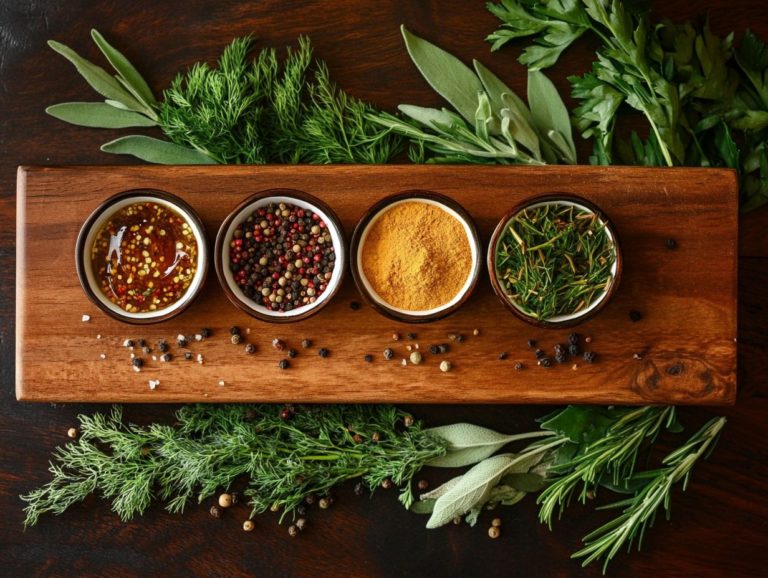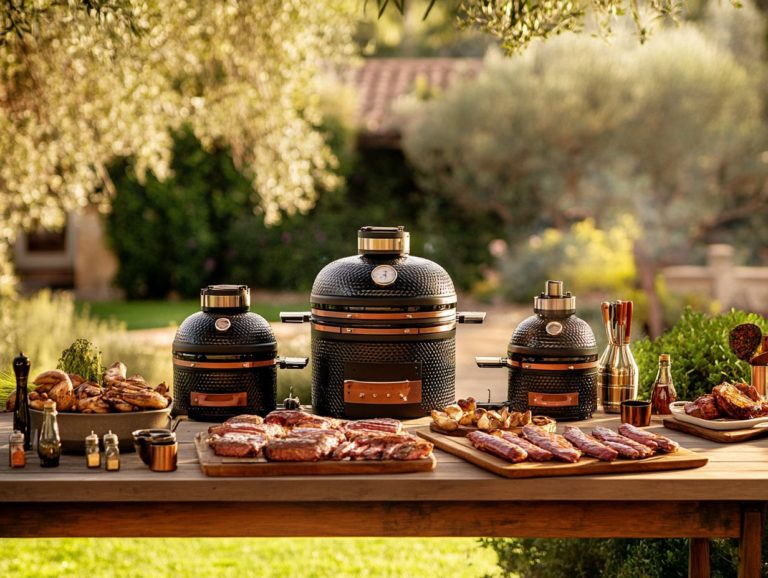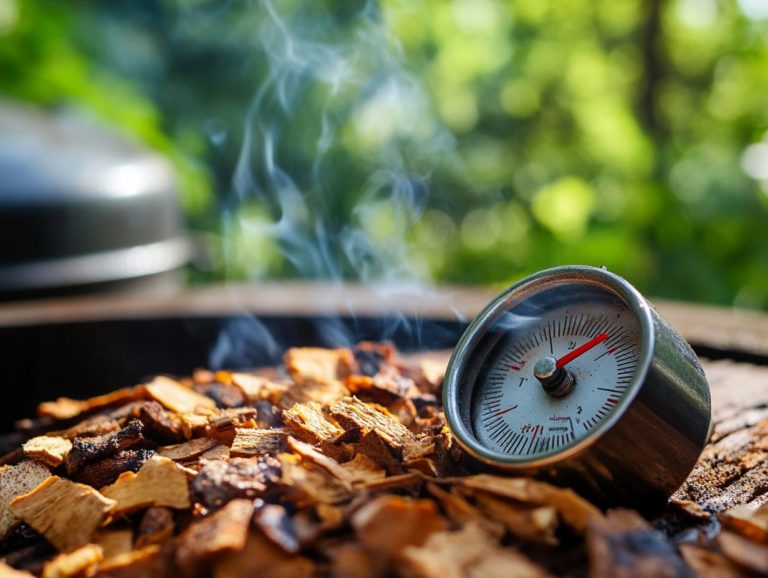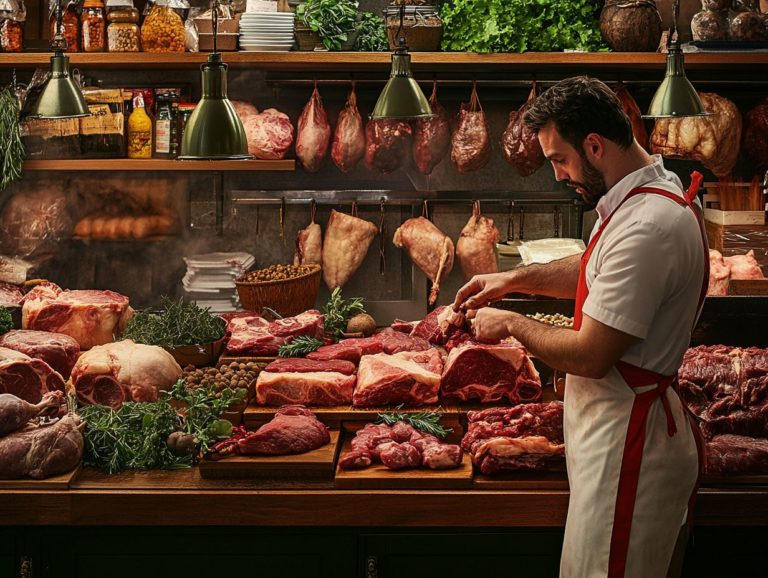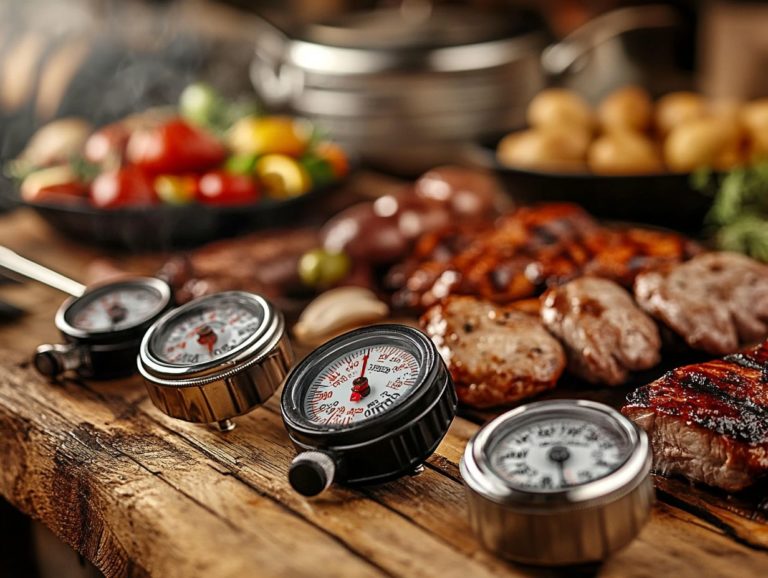The Best Wood for Smoking Meat: A Comprehensive Guide
Smoking meat is not just a cooking method; it s an art form that transforms ordinary cuts into delicious meals. Get ready to elevate your BBQ game!
Your choice of wood is vital in this culinary journey, as it significantly influences flavor, aroma, and cooking temperature. This guide will walk you through various types of wood for smoking, helping you understand their unique characteristics and how to expertly pair them with different meats for optimal results.
You will uncover game-changing tips that will transform your BBQ, including common pitfalls to avoid and important factors to consider. This ensures that your smoking experience is not only delicious but also immensely rewarding.
Contents
- Key Takeaways:
- Types of Wood for Smoking Meat
- Factors to Consider When Choosing Wood
- Best Woods for Different Types of Meat
- How to Prepare and Use Wood for Smoking
- Common Mistakes to Avoid When Smoking with Wood
- Frequently Asked Questions
- What is the best type of wood for smoking meat?
- Why is it important to choose the right wood when smoking meat?
- How do I know which type of wood is best for a specific type of meat?
- Can I mix different types of wood when smoking meat?
- Are there any types of wood that should be avoided when smoking meat?
- Is it necessary to soak wood chips or chunks before using them for smoking meat?
Key Takeaways:

- Choose the best wood for smoking meat based on its flavor, heat output, availability, and cost.
- Match specific types of wood with different meats for the best flavor. For example, use hickory for pork and mesquite for beef.
- Properly prepare and use wood for smoking by soaking it and placing it correctly in the smoker to avoid common mistakes like bitter or overpowering smoke flavor.
Types of Wood for Smoking Meat
When venturing into the world of smoking meats, the type of wood you select is crucial for crafting the perfect flavor. Each wood variety imparts its own unique essence, whether you prefer the bold smokiness of hickory or the delicate sweetness of apple wood.
Knowing about different woods makes your BBQ taste better. From the intense flavor of mesquite and the richness of oak to the fruity notes of cherry and the warmth of pecan, each wood offers distinct characteristics that can transform a simple meal into a delightful experience.
Overview of Different Wood Types
Different wood types used in smoking meats can elevate your BBQ experience with a delightful array of flavors. Hickory offers a strong, robust profile that commands attention, while apple wood brings a gentle sweetness that s simply irresistible.
As you dive deeper into smoking, you ll find that mesquite serves up a bold, earthy taste, ideal for cuts like brisket. Cherry wood, on the other hand, adds a delicate, fruity nuance that pairs beautifully with chicken and pork. This flavor matching is key to crafting the perfect smoked meat.
Smoking times vary depending on the type of wood. Hardwoods like oak and maple (which burn longer) are perfect for extended smoking sessions, while lighter fruit woods deliver flavor with a quicker punch. Utilizing the right smoking wood can dramatically improve your BBQ results.
Understanding the difference between hardwoods and fruit woods is essential. Hardwoods usually provide deeper, more intense smoked flavors, while fruit woods contribute a lighter, nuanced sweetness. For the ultimate flavor combinations, consider mixing woods blending hickory with a hint of cherry creates a well-rounded experience, or try pairing apple wood with pecan to elevate your pork dishes.
Factors to Consider When Choosing Wood
Selecting the ideal wood for smoking requires understanding several factors that can influence the flavor and quality of your smoked meats. Consider the wood’s flavor, heat output, and practical aspects like availability and cost.
These elements are crucial for BBQ enthusiasts like yourself, aiming to elevate your smoking techniques to perfection.
Flavor Profile and Heat Output
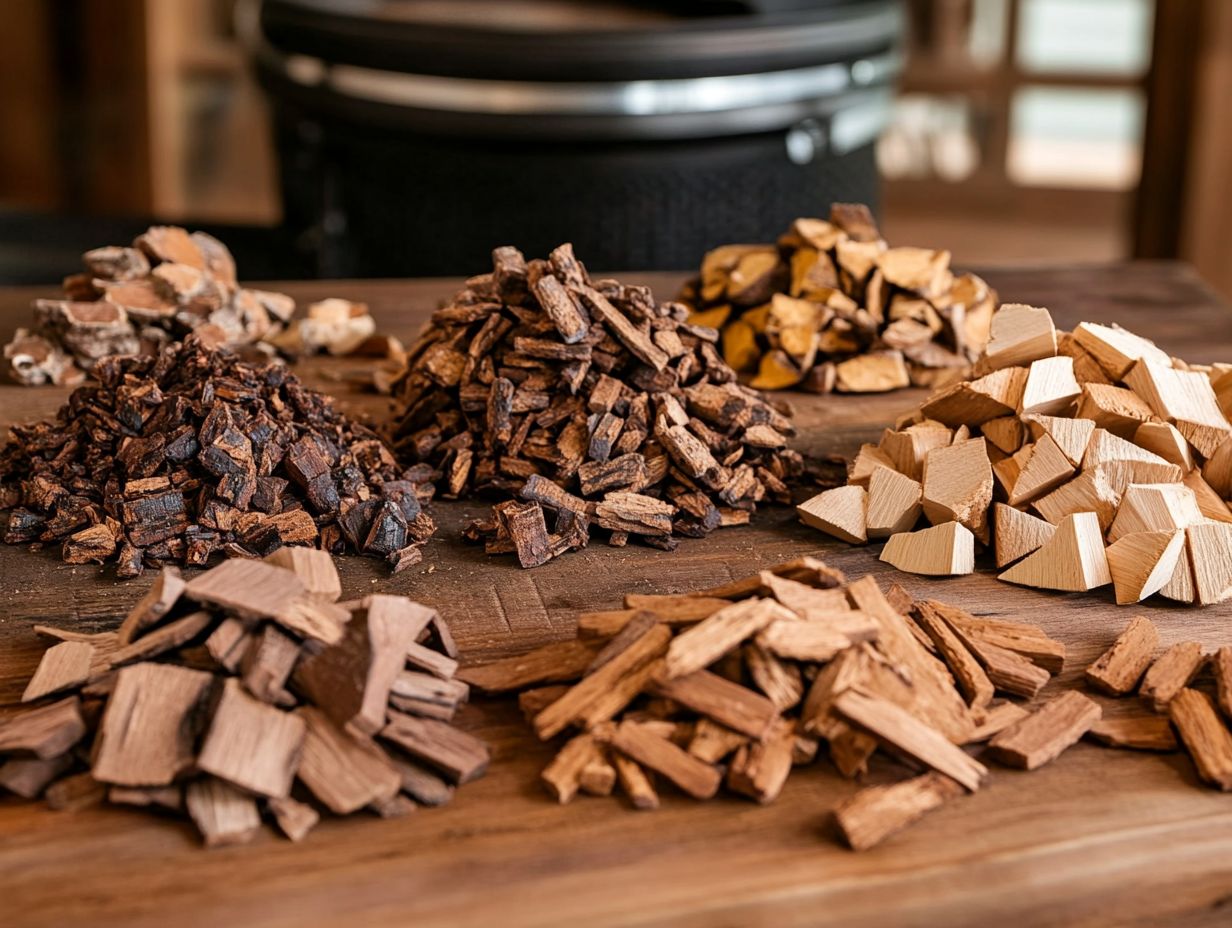
The flavor profile and heat output of each wood type are vital considerations when smoking meats, as they directly influence the outcome of your BBQ creations. For instance, mesquite delivers a robust flavor, while hickory offers a balanced, smokier essence that can elevate your dishes.
Different woods impart distinct flavors and affect the cooking temperature and smoking duration. Fruitwoods like apple and cherry bring a mild, sweet profile to the table, making them ideal partners for poultry and pork. These woods enhance the natural juices without overwhelming them.
In contrast, denser woods like oak provide a consistent, hotter burn, perfect for larger cuts of beef or brisket that demand longer smoking times.
To achieve the best results, consider pairing mesquite with strong-flavored meats like beef or lamb. Opt for the subtler profiles of fruitwoods for lighter meats like chicken. Pairing the right wood makes a big difference in flavor and cooking conditions, leading to an exceptional BBQ experience that impresses discerning palates.
Availability and Cost
When selecting the best wood for smoking, availability and cost are key factors that can greatly influence your choice. Some types of wood might be easily accessible through local suppliers, while others could come with a premium price tag, affecting your BBQ budget.
To kick off your search for local suppliers, consider stopping by farmer’s markets, specialty barbecue shops, or even lumber yards that provide seasoned wood. You can also engage with local BBQ communities for recommendations.
While planning your budget, keep an eye on seasonal availability; certain woods might be more affordable during specific times of the year. While it s tempting to go for the cheapest option, finding a balance between cost and quality is essential. Investing in high-quality wood will elevate the flavor profile of your smoked dishes, ensuring you fully enjoy the ultimate BBQ experience without compromise.
Best Woods for Different Types of Meat
Choosing the right wood for various meats is essential for achieving remarkable flavor in your smoked BBQ creations. For instance, pork harmonizes beautifully with hickory or apple wood, while chicken delights in the gentle sweetness of cherry wood.
Matching Wood to Meat for Optimal Flavor
Matching the right wood to the type of meat you re smoking is crucial for achieving optimal flavor. Each wood variety brings its own unique characteristics, which can either complement or elevate the natural flavors of the meat.
For example, hickory has a strong, sweet flavor that works well with pork, especially ribs and shoulders. Mesquite delivers an intense smoke that complements beef cuts like brisket. If you prefer something milder, fruitwoods such as apple and cherry provide a sweeter smoke, making them excellent options for poultry and fish.
Many BBQ chefs suggest experimenting with different combinations, like blending oak with fruitwood, to create harmonious flavors that truly elevate your dish. Don t overlook the impact of soaking times for your wood; this little tweak can significantly influence the final taste, allowing you to discover the perfect balance that suits your palate.
How to Prepare and Use Wood for Smoking

Preparing and utilizing wood for smoking is an important part of the smoking process that significantly impacts the quality of the meat and the overall smoking experience.
Soaking your wood is vital, and ensuring the correct placement of wood chips in the smoker is essential for achieving a consistently even and flavorful smoke, helping to burn cleanly and optimize flavor.
Proper Soaking and Placement Techniques
Proper soaking and placement techniques are essential in the smoking process. Soaking wood chips facilitates a slow release of smoke, leading to a more even flavor profile. Strategic placement ensures optimal heat distribution, meaning the heat spreads evenly throughout the smoker.
Soaking different types of wood like hickory, mesquite, or apple not only elevates the flavor but also prevents the wood from igniting too rapidly. This allows you to maintain a steady temperature, ensuring that your meat gradually absorbs the smoke. For the best results, aim to soak wood chips for about 30 minutes to an hour, while larger chunks can benefit from a soak lasting several hours or even overnight.
In terms of placement, arranging the soaked wood thoughtfully in the smoker is crucial. Dense woods should be positioned closer to the heat source to promote thorough combustion, while lighter varieties can be set further away for a more gentle infusion of flavor. Mastering these techniques will directly influence your smoking process, imparting a unique character to your final dish.
Common Mistakes to Avoid When Smoking with Wood
Avoiding common mistakes when smoking with wood is crucial for ensuring a truly successful BBQ experience. Many novice BBQ enthusiasts inadvertently end up with a bitter or overpowering smoke flavor, often due to improper wood selection or flawed smoking techniques.
By honing your skills and being mindful of your choices, you can elevate your BBQ game to new heights. Using the right smoking woods significantly impacts the flavor and quality of your creations.
Tips for Avoiding Bitter or Overpowering Smoke Flavor
To prevent those unpleasant, overpowering smoke flavors from ruining your BBQ creations, embrace effective smoking techniques and familiarize yourself with the unique characteristics of various wood types. This approach guarantees a well-balanced flavor profile.
Opting for milder woods, particularly fruit varieties like apple or cherry, can do wonders when smoking delicate meats such as chicken or fish. These woods provide gentle, sweet notes that enhance the dish without eclipsing its natural flavors.
Combining different wood types can elevate your BBQ game, allowing you to craft a more complex and nuanced flavor profile. For example, pairing oak with hickory creates a robust foundation while softening any sharp edges.
Paying attention to smoke intensity is equally important. Using well-seasoned wood chips and regulating airflow helps prevent the smoke from becoming too acrid. This way, your finished product remains savory and undeniably inviting.
Frequently Asked Questions
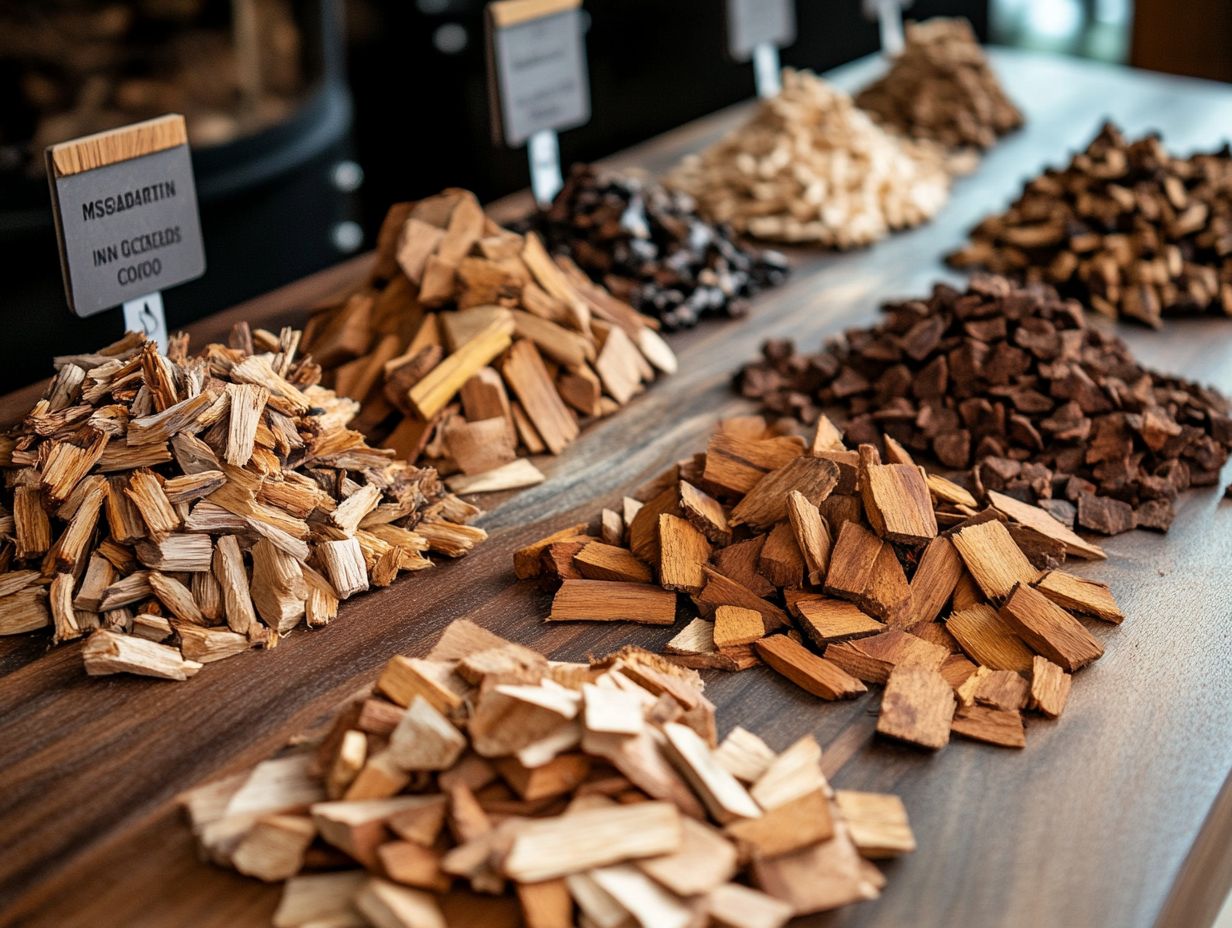
What is the best type of wood for smoking meat?
The best type of wood for smoking meat depends on the type of meat being smoked and personal preference. Some popular options include hickory, mesquite, and applewood.
Why is it important to choose the right wood when smoking meat?
The type of wood used can greatly impact the smoke flavor and aroma of the smoked meat. Choosing the right wood ensures the best results and enhances the overall taste of the meat.
How do I know which type of wood is best for a specific type of meat?
Generally, stronger flavored woods like hickory and mesquite are best for red meats like beef and pork, while milder woods like apple and cherry are ideal for poultry and fish. However, feel free to experiment and find your own preferred flavor combinations.
Can I mix different types of wood when smoking meat?
Yes, you can mix different types of wood when smoking meat. This can add complexity to the flavor and create a unique flavor. However, be careful not to overwhelm the meat with too many strong flavors.
Are there any types of wood that should be avoided when smoking meat?
Yes, some types of wood can produce toxic smoke when burned, such as pine, cypress, and cedar. It is best to stick with hardwoods specifically meant for smoking meats.
Get ready to elevate your BBQ skills! Try these tips at your next BBQ and taste the difference!
Is it necessary to soak wood chips or chunks before using them for smoking meat?
Soaking wood chips or chunks is a choice you can make. It can help the wood burn slower and create more smoke, but it s not essential.
Many pitmasters enjoy soaking because it adds a unique flavor to the meat. Experiment with both soaked and dry wood to find what you like best!
Have fun with your smoking adventures and don’t hesitate to share your experiences with others!

